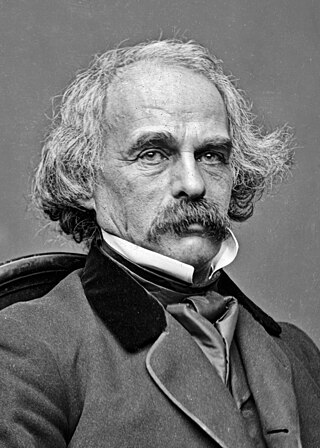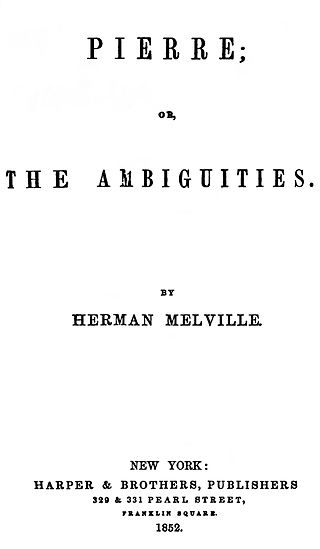
Herman Melville was an American novelist, short story writer, and poet of the American Renaissance period. Among his best-known works are Moby-Dick (1851); Typee (1846), a romanticized account of his experiences in Polynesia; and Billy Budd, Sailor, a posthumously published novella. At the time of his death, Melville was no longer well known to the public, but the 1919 centennial of his birth was the starting point of a Melville revival. Moby-Dick eventually would be considered one of the great American novels.

Moby-Dick; or, The Whale is an 1851 novel by American writer Herman Melville. The book is the sailor Ishmael's narrative of the maniacal quest of Ahab, captain of the whaling ship Pequod, for vengeance against Moby Dick, the giant white sperm whale that bit off his leg on the ship's previous voyage. A contribution to the literature of the American Renaissance, Moby-Dick was published to mixed reviews, was a commercial failure, and was out of print at the time of the author's death in 1891. Its reputation as a Great American Novel was established only in the 20th century, after the 1919 centennial of its author's birth. William Faulkner said he wished he had written the book himself, and D. H. Lawrence called it "one of the strangest and most wonderful books in the world" and "the greatest book of the sea ever written". Its opening sentence, "Call me Ishmael", is among world literature's most famous.

Nathaniel Hawthorne was an American novelist and short story writer. His works often focus on history, morality, and religion.

A short story is a piece of prose fiction that can typically be read in a single sitting and focuses on a self-contained incident or series of linked incidents, with the intent of evoking a single effect or mood. The short story is one of the oldest types of literature and has existed in the form of legends, mythic tales, folk tales, fairy tales, tall tales, fables and anecdotes in various ancient communities around the world. The modern short story developed in the early 19th century.
This article contains information about the literary events and publications of 1855.
This article contains information about the literary events and publications of 1820.

Harper's Magazine is a monthly magazine of literature, politics, culture, finance, and the arts. Launched in New York City in June 1850, it is the oldest continuously published monthly magazine in the United States. Harper's Magazine has won 22 National Magazine Awards.

Temple Bar was the principal ceremonial entrance to the City of London from the City of Westminster. In the middle ages, London expanded city jurisdiction beyond its walls to gates, called ‘bars’, which were erected across thoroughfares. To the west of the City of London, the bar was located adjacent to the area known as the Temple. Temple Bar was situated on the historic royal ceremonial route from the Tower of London to the Palace of Westminster, the two chief residences of the medieval English monarchs, and from the Palace of Westminster to St Paul's Cathedral. The road east of the bar within the City was Fleet Street, while the road to the west, in Westminster, was The Strand.
"Bartleby, the Scrivener: A Story of Wall Street" is a short story by the American writer Herman Melville, first serialized anonymously in two parts in the November and December 1853 issues of Putnam's Magazine and reprinted with minor textual alterations in his The Piazza Tales in 1856. In the story, a Wall Street lawyer hires a new clerk who, after an initial bout of hard work, refuses to make copies or do any other task required of him, refusing with the words "I would prefer not to."

Robert Fordyce Aickman was an English writer and conservationist. As a conservationist, he co-founded the Inland Waterways Association, a group which has preserved from destruction and restored England's inland canal system. As a writer, he is best known for his supernatural fiction, which he described as "strange stories".

Pierre; or, The Ambiguities is the seventh book by American writer Herman Melville, first published in New York in 1852. The novel, which uses many conventions of Gothic fiction, develops the psychological, sexual, and family tensions between Pierre Glendinning; his widowed mother; Glendinning Stanley, his cousin; Lucy Tartan, his fiancée; and Isabel Banford, who is revealed to be his half-sister. According to scholar Henry A. Murray, in writing Pierre Melville "purposed to write his spiritual autobiography in the form of a novel" rather than to experiment and incidentally work some personal experience into the novel.

The Knickerbocker, or New-York Monthly Magazine, was a literary magazine of New York City, founded by Charles Fenno Hoffman in 1833, and published until 1865. Its long-term editor and publisher was Lewis Gaylord Clark, whose "Editor's Table" column was a staple of the magazine.
The Piazza Tales is a collection of six short stories by American writer Herman Melville, published by Dix & Edwards in the United States in May 1856 and in Britain in June. Except for the newly written title story, "The Piazza," all of the stories had appeared in Putnam's Monthly between 1853 and 1855. The collection includes what have long been regarded as three of Melville's most important achievements in the genre of short fiction, "Bartleby, the Scrivener", "Benito Cereno", and "The Encantadas", his sketches of the Galápagos Islands.

Miss Marple's Final Cases and Two Other Stories is a short story collection written by Agatha Christie and first published in the UK by Collins Crime Club in October 1979 retailing at £4.50. It was the last Christie book to be published under the Collins Crime Club imprint although HarperCollins continue to be the writer's UK publishers.
"The Encantadas, or Enchanted Isles", is a novella by American author Herman Melville. First published in Putnam's Magazine in 1854, it consists of eleven philosophical "Sketches" on the Galápagos Islands, then frequently known as the "Enchanted Islands" from the treatcherous winds and currents around them. It was collected in The Piazza Tales in 1856. The Encantadas was a success with the critics and contains some of Melville's "most memorable prose".
"Isle of the Cross" is a possible unpublished and lost work by Herman Melville, which would have been his eighth book, coming after the commercial and critical failures of Moby-Dick (1851) and Pierre: or, The Ambiguities (1852). Melville biographer Hershel Parker suggests that the work, perhaps a novel, perhaps a story, was what had been known as the "story of Agatha," completed around May 1853. He further suggests that finishing the work showed that Melville had not, as many biographers argued, been discouraged and turned away from fiction.

The Crane and Company Old Stone Mill Rag Room is one of the oldest surviving buildings of Crane & Co., one of the oldest papermaking businesses in Berkshire County, Massachusetts. It is located in southwestern Dalton, on a site where paper has been manufactured since the early 19th century. The building, originally used for processing rags, has housed the Crane Museum of Papermaking since 1930, and was designated a National Historic Landmark in 1983.
Michael Shelden is an American biographer and teacher, notable for his authorized biography of George Orwell, his history of Cyril Connolly's Horizon magazine, his controversial biography of Graham Greene, and his study of the last years of Mark Twain, Man in White. In March 2013 his Young Titan: The Making of Winston Churchill was published. In 2016 his biography of Herman Melville, Melville in Love, was published by Ecco/HarperCollins.

The bibliography of Herman Melville includes magazine articles, book reviews, other occasional writings, and 15 books. Of these, seven books were published between 1846 and 1853, seven more between 1853 and 1891, and one in 1924. Melville was 26 when his first book was published, and his last book was not released until 33 years after his death. At the time of his death he was on the verge of completing the manuscript for his first novel in three decades, Billy Budd, and had accumulated several large folders of unpublished verse.
"Cock-A-Doodle-Doo! or, The Crowing of the Nobel Cock Beneventano" is an 1853 short story by the American writer Herman Melville. It was first published in the December 1853 issue of Harper's Magazine, the same month the second installment of "Bartleby, the Scrivener" appeared in Putnam's. The story remained uncollected until 1922, when Princeton University Press included it in The Apple-Tree Table and Other Sketches.












